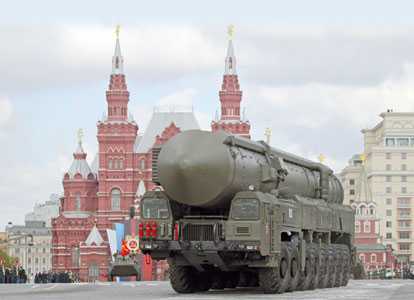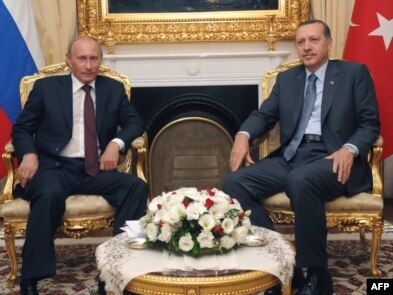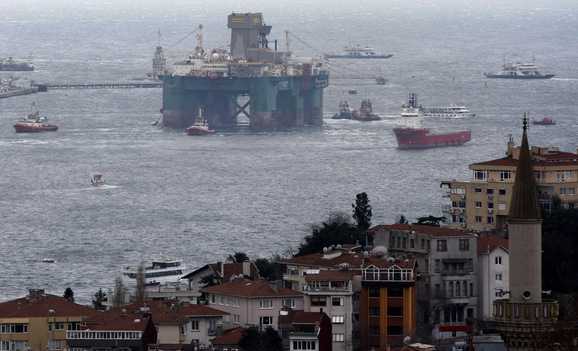Chums: Turkish Prime Minister Recep Tayyip Erdogan (right) meets with his Russian counterpart, Vladimir Putin, in Ankara on August 6.
August 31, 2009
According to Turkey’s popular “Zaman” newspaper, the country can now claim the title of “world’s largest energy hub.”
While over a decade of government policy has sought to transform Turkey’s energy sector into first a European, then a regional, and now a global energy hub, a rash of recent international agreements, according to “Zaman,” have enabled Turkey to finally attain that status.
Deals with European Union member states on the Nabucco natural-gas pipeline, with Russia on the competing South Stream project, with Qatar on liquefied natural gas and a possible pipeline, with Azerbaijan on gas supplies for its isolated Nakhchivan autonomous region, and with Syria on a gas-import deal have kept Turkey’s energy aspirations in the headlines.
These developments should not come as a surprise.
For those looking at the big picture, Anatolia’s tailor-made to be the geographic center of crisscrossing pipelines, inputs, and outlets for the flow of hydrocarbon resources. Turkey is surrounded by the world’s largest natural-gas reserves — Russia, the greater Caspian region, Iran, Iraq, the Gulf and Egypt — and one of the world’s greatest markets, the European Union.
Decision makers in Ankara certainly see this big picture, and with projects like Nabucco are pushing to realize Turkey’s potential.
Their counterparts in Brussels and other European capitals, however, often do not see the same picture.
Turkey, for European decision makers, is the alternative energy corridor to the resources of the Caspian, a thoroughfare to connect EU consumers with producers such as Azerbaijan and Turkmenistan, allowing for supply diversification and less dependence on problematic Russian reserves.
This limited view often leads to incongruent policies between Ankara and Brussels, not to mention already Turkey-skeptical leaders such as France’s Nicholas Sarkozy and Germany’s Angela Merkel. The prolonged and difficult negotiations over Nabucco are just one example.
EU Myopia
European energy policies, to the extent that there has been any unity of focus on reaching alternative reserves, have yet to take into account the enormous potential of genuinely partnering with Turkey as a global energy hub — as opposed to just hammering out a deal with Turkey because it controls the territory between the EU and the Caspian.
It goes without saying that this myopia has led to complacency in Turkey’s EU accession process. One of the world’s largest markets for hydrocarbons has yet to open energy negotiations with the world’s largest energy hub, right on its doorstep.
Most regrettably, this limited view of Turkey’s energy role among Western decision makers has contributed to an overall trans-Atlantic sense of “the loss of Turkey.” Ankara’s deals with Moscow on South Stream are seen as undermining the strategic Western-oriented Nabucco project. Turkish policymakers’ openness to including Russia and Iran in projects that are at least partly meant to strengthen the sovereignty of those powers’ smaller neighbors — and Prime Minister Tayyip Erdogan’s chummy relationship with Russian Prime Minister Vladimir Putin — have more than just raised eyebrows in Washington and Brussels.
But, again, that view ignores the bigger map on the tables of Ankara. Turkey’s energy ambitions have evolved into a fully fledged multivector policy. And, given Turkey’s overwhelming dependence on Russian natural gas for its own consumption, it is surprising that Ankara is still so open to Western-oriented projects.
To deny Turkey’s multivector energy policies and potential would be to take Ankara for granted. It is a losing proposition for proponents of Western-oriented projects such as Nabucco to expect not to compete with counteroffers from the other major energy players in Turkey’s neighborhood.
It behooves Western decision makers to fully appreciate Turkey’s energy big picture or risk upcoming surprises such as Armenian electricity exports to Turkey and a Russia-dominated Turkish nuclear sector. The “world’s largest energy hub” headline is not only aimed at puffing up chests in Turkey, but at turning heads in Europe and the United States.
Alexandros Petersen is Dinu Patriciu fellow for trans-Atlantic energy security and associate director of the Eurasia Energy Center at the Atlantic Council. The views expressed in this commentary are the author’s own and do not necessarily reflect those of RFE/RL.
https://www.rferl.org/a/Turkeys_Multivector_Energy_Hub_Ignore_At_Your_Peril/1811254.html






